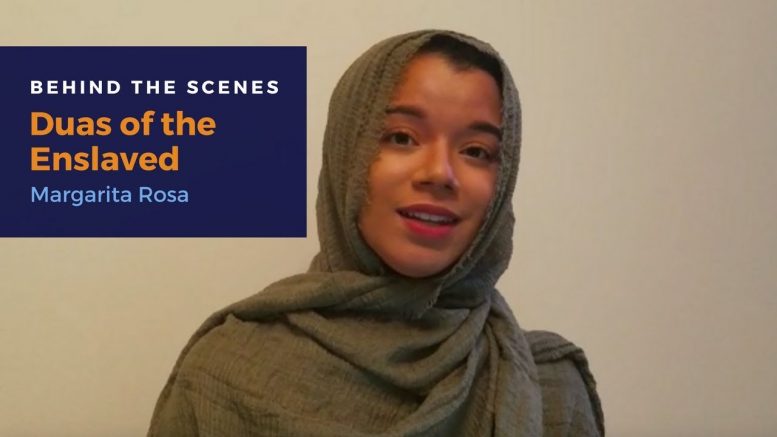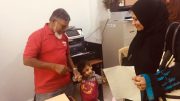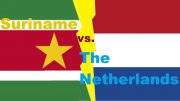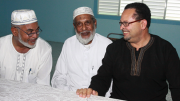Reproduced from Yaqeen Institute, original post here, with permission.
In Ramadan of 1835, a group of enslaved African Muslim clerics in Salvador of Bahía, Brazil organized one of the best recorded slave rebellions in the Americas. The history of Muslim rebellion[1] against enslavement in the Americas dates back to 1522, when enslaved Muslims of Wolof origin revolted in Santo Domingo,[2] twelve years after the formal commencement of the transatlantic slave trade.[3] Three centuries later, enslaved Muslims in Bahía, Brazil would organize an uprising that would become the last major slave rebellion in Brazilian history.[4] The 1835 Malê[5] revolt, as historians refer to it, was a rebellion rooted in the spiritual fortification cultivated in Bahían madrassas.[6] The Malê revolt was not purely a physical attempt to liberate Africans from the institution of slavery. Rather, the Malê revolt was a spiritual struggle organized within Bahían madrassas, brought about by the desire to reunite with exiled spiritual leaders, and ultimately, to preserve Islamic education and through it, spiritual fortification. In an effort to contribute to the work of scholars who enjoin cross-Atlantic research rooted in the notion that African cultures did not perish on slave ships, I will argue that the intellectual society built by Muslims up to the 1835 Malê revolt was rooted in practices that were central to West African understandings of learning, schooling, and embodied knowledge.
Bahían Muslim Intellectual Society
There is a prevalent assumption among experts and non-experts alike that chattel and plantation slavery meant the complete annihilation of social, cultural, and intellectual formations among enslaved Africans.[7] This is far from the truth, especially in Brazil, which imported the highest number of enslaved Africans via the transatlantic slave trade—a staggering twenty-five percent of all slaves spread across North, Central, and South America.[8] After the Haitian Revolution resulted in the formation of the first black republic in the Western hemisphere in 1804, other colonies like Cuba and Brazil hoped to replace the massively successful sugar colony. Thus, following the Haitian Revolution, imports across the Americas grew, particularly in Brazil. Moreover, a catastrophic combination of internal African politics and continuous European instigation led to an exacerbation of the slave trade around the Bight of Benin, which led to higher exports from that area. Most of the slaves that ultimately formed nineteenth century Bahían Muslim society were prisoners of war from either side of the wars that would eventually lead to the formation of the Sokoto Caliphate.[9] In Brazil, this population were known as Nagôs, an inclusive term indicating Yoruban ethno-linguistic groups. The Nagôs of Brazil rebeled dozens of times in the forty years before the Malê revolt, although these rebellions would usually only garner the participation of a singular ethnic group, most often the Hausas. The Malê revolt, on the other hand, drew participants from virtually every ethnic group of African-born slaves and freedmen in Bahía.[10] No Brazilian-born Africans are known to have participated in the Malê revolt, however. Brazilian-born Africans and mulattos were highly distrusted among the African-born community due to their unwavering loyalty to the Portuguese-Brazilian ruling social class. The Malê revolt was therefore undertaken by African-born slaves and freedmen. Contrary to what the name suggests, however, not all participants in the Malê revolt were Muslim, although the vast majority were. What makes the name appropriate, however, is not the exclusive participation of Muslims. Rather, it is the fact that the rebellion was organized in madrassas and born out of particular relationships between Muslim teachers and their devoted students.
Most of the ʿulama[11] in Bahía were enslaved, as were their students.[12] While freedmen played a very special role in the formation of madrassas and free teachers were the only ones able to cross towns and teach elsewhere, most of the Islamic education in Bahía was centered around the conditions of slavery and a highly-racialized system of power, where even freedmen were highly repressed. Indeed, the formation of madrassas was by necessity a secret enterprise. In this context, the house of Manoel Calafate and Aprígio, two elderly free Nagôs, became a prominent location for the gathering of Muslims, prayer, and Islamic education. Testimonies given after the insurrection demonstrated that Aprígio and Calafate were both respected teachers who were adored by their devoted students—Calafate would even be called “Paí” in many of the testimonies, meaning “father.” Their madrassa was hidden in a rented house which for the most part proved inconspicuous, even as students would wander in and out throughout the day.[13]
The preservation of Muslim tradition and pious acts was hidden from the visible fabric of Bahían society, yet present in its innermost seams. The creation of Muslim attire was a fundamental aspect of Bahían pious acts, since slaves were often made to wear the most undignified of garments. Thus, wearing Muslim clothing in a society that had stripped them of that virtue was a way for enslaved and subjugated Muslims to work towards a bodily vindication that might bestow a sense of dignity and identity where it had been lost. In that very home, Aprígio was known for making kaftans and kufis, many of which were found in the aftermath of the revolt. An elderly Nagô slave by the name of Luís also sewed Muslim garments. Testimonies about Luís were centered around tales of students coming to him and asking him to pray for them. If his mere presence was filled with the hope of divine intervention, then so perhaps might have been his clothing. The fact that Muslim garments were made by religious leaders suggests that wearing these garments had become an essential aspect of the embodied spiritual formation of Bahían Muslims.
Yet these garments were not worn outside of religious spaces, for fear of them becoming recognizable symbols. Thus, spaces of spiritual fortification became places that were used for various acts of piety among the Bahían community. An elderly Hausa freedman by the name of Dandará was among the freedmen who provided spaces for Muslim pedagogical formation in Bahía. Dandará owned a tobacco shop that he used as a musalla and a madrassa, congregating Muslims for various pious activities such as formal prayer and dhikr.[14] According to one testimony, Dandará extended himself to provide two lessons per day aos pretos (to blacks). The portrait of Bahían Islamic teachers is invariably one of complete selflessness in the face of the most limiting constraints, and Dandará was no exception. The pious elderly man lived for his students and in order to praise God. In a gripping testimony, a mulatto man who lived above Dandará’s shop recounted that, through the floorboards, he would see the old man take large prayer beads, rub them against his hands repeatedly, and shout out to the heavens.[15]
Luis Sanin,[16] an elderly enslaved Nagô, like Dandará, exemplified qualities of complete devotion to God and a commitment to the progress of enslaved African Muslims. From testimonies and letters, we know that Sanin was a cherished member of the Bahían Muslim community. One extant letter written mostly in Hausa is an appeal to Sanin from a slave named ‘Abd al-Qadir for Sanin to offer his prayers and condolences after ‘Abd al-Qadir’s newborn daughter died. The letter contains an emotionally devastating supplication that shows the deeply spiritual relationship between teacher and student,[17] a profound indication of the preservation of Islamic pedagogical methods across the Middle Passage. Sanin used the house of two free Muslims to teach Muslims how to perform prayers and supplications.[18] Yet, he also took practical approaches to ensuring the progression of the Muslim community and the preservation of responsibilities that Muslims have towards one another. In one of the most outstanding cases from the records on the Malê Revolt, Sanin organized the collection of funds from enslaved Muslims for the performance of pious acts of charity (zakat). An enslaved person in Bahía might have acquired funds through some kind of loose employment or payment for small favors, and in the years leading up to the 1835 revolt, the enslaved Muslims would have used their minimal funds to perform acts of zakat. Sanin designated one-third of the funds to be spread amongst the enslaved, even as those giving zakat themselves were slaves and occupying the lowest social strata. The institution of zakat among the African Muslims suggests that the condition of enslavement did not negate what some Bahían slaves felt was an enduring responsibility for the preservation of Islamic codes, which included the concession that, even as slaves, someone else’s condition was more in need of ailment than the one giving zakat. The second-third of the zakat collection was used to buy fabric to make Muslim clothing, which as I suggested before, was an essential component of Bahían spiritual life. The remaining third was used to obtain the manumission of slaves, in the event that such arrangements were possible.[19]
In another town in Bahía, in the Vitória district, two Muslims enslaved by Englishmen were given permission to build a hut in the plantation, which they used as a madrassa. Perhaps due to the prevalence of abolitionist thought in England, there are many cases in Bahía of tolerance among the English for the various activities of their slaves. Even if this tolerance did not translate to manumission, the permission to build a school for slaves to “memorize and write down prayers” was an unfathomable gift to the pious enslaved Muslim.[20] Furthermore, this madrassa had three prominent teachers by the name of Dassalú (Mama), Gustard (Buremo), and Nicobé (Sule).[21] But teaching Qur’anic recitation was not the only thing that made all of these madrassas similar to those of West Africa. After 1835, authorities confiscated dozens of wooden boards with handles cut out on one of the edges which the Nagô Muslims of Bahía called a wàláá. When asked about these boards, a Hausa slave named Albino confirmed what anyone conscious of the methods of West African Islamic and instruction would already be familiar with. Enslaved Bahían Muslims would write their lessons on the wooden tablets with long sticks dipped in a kind of ink and, after the lesson,[22] the enslaved Muslims would wash the boards off and drink the ink of the water.[23] The water from the Qur’anic passages would provide barakah (blessings) when consumed, and was part and parcel of the spiritual experience of learning, in West Africa as in Bahía.
Two elderly Muslims were at the center of Bahían spiritual and intellectual formations. Ahuna, an enslaved Nagô, was considered by many of the testimonies the maioral (the leader) of the Bahían Muslim community. João José Reis suggests that Ahuna would have been the most wanted man by authorities after the 1835 revolt.[24] Yet the elderly man’s life does not paint a portrait of a dangerous man. Ahuna was enslaved by a Brazilian man who made a living selling drinking water. As his slave, Ahuna had to comply with the man’s orders even though it was against Ahuna’s Islamic values to charge money for water.[25] Ahuna’s specific contributions to the Bahian Muslim community are not well known, but what is known is that he was a central figure in the Malê revolt. A few months before the rebellion, Ahuna was charged with a crime, and although the crime was minor, he was exiled to another town. Clearly, his activities were perceived as dangerous to Bahían authorities. As a true testament of the status of Ahuna and the devotion of his followers, his students followed him all the way to the port. The day before the rebellion, authorities had already heard that the Nagôs were planning to “reunite” with their maioral, Ahuna.[26]
The second figure who was absolutely central to the formation of the Malê revolt was an elderly enslaved Nagô who, although he appears as Pacífico Licutan[27] in records, referred to himself as Bilal, a clear ode to Bilal ibn Rabah, the first muʾazzin of Islam, and an African who spent most of his life as a slave. Our Bahían Bilal was enslaved by a brutal owner who would have him spend his day rolling cigars which he then would sell.[28] Despite this condition, testimonies say that Bilal had students coming in and out of his room.[29] They would wait outside until he called on them. The manumission of slaves through zakat was often the way that students would liberate their teachers. Twice Bilal’s students tried to buy his freedom, but the owner refused. Then, after becoming indebted to the Carmelite Order of Friars, Bilal’s owner sold him off to be auctioned. Bilal spent that Ramadan in prison, while his students took to plotting a rebellion in which the first plan of action was to liberate their beloved teacher.
Historian Rudolph Ware[30] suggests that the bearers of knowledge as per the pedagogical values of West African Islamic societies were considered to themselves be walking manifestations of the Qur’an. Internalized knowledge becomes embodied knowledge—Islamic knowledge becomes part of the body itself. The emphasis on Qur’anic knowledge as an instruction of both the mind and the body is rooted in a hadith in which A’isha, the wife of Prophet Muhammad ﷺ, is asked to speak about the qualities of the Prophet ﷺ, and she describes him as “the walking Qur’an on earth.”[31] The walking Qur’an is thus he or she who internalizes the teachings of the Qur’an and applies them to their entire life—enjoining to truth and forbidding bad, no matter where they may be and no matter their condition. In Bahía, where the only people learned in Qur’an verses and recitation were elderly teachers such as Calafate, Dandará, Ahuna, and Bilal, the knowledge that they possessed vis-à-vis their bodies and that they transmitted and affirmed vis-à-vis their bodies, positioned them as walking Qur’ans. When a walking Qur’an was jailed or exiled, as Ahuna and Bilal were, Ware argues that it was as though one were putting the Qu’ran in chains. And this was a direct incentive towards rebellion. Ware writes, “Seeing the Book in chains was both a real and a metaphorical point of no return. Men of letters took up arms…choosing to forgo long-established traditions of clerical pacifism, neutrality, and pious distance from power.” [32] Thus, it is no surprise that months after Ahuna was exiled and weeks after Bilal was imprisoned to be sold off to a new master, Bahían Muslims saw an armed revolt as the only way to unchain their walking Qur’ans.
Malê Revolt
The rebellion was planned to take place in the month of Ramadan on January 25, 1835 during the Catholic celebration of Nossa Senhora da Guia.[33] While some white Brazilians might have sensed the belligerent conspiracy that was waiting at their doorstep, the rumors floating rapidly the day before the planned rebellion solidified the need to set up vast mechanisms of defense. The indissoluble loyalty between whites, free blacks, and Brazilian-born slaves assured that any conspiracy revealed to the latter two groups would surely find its way to the white population. And indeed, word of a rebellion reached the ears of whites via free blacks, who were intent on preserving their relationships with their previous masters as well as their position in a world stratified by the very men against whom the conspiracy was to be unleashed. A surviving letter written by Domingos Fortunato, a free black, to his former master, reveals an attempt by free blacks to demonstrate loyalty to the white Brazilian population, to whom they felt a bond that differentiated them, ontologically, from the enslaved Africans who he portrayed as perpetually intent on wreaking havoc. A small number of former slaves are known to have participated in the conspiracy, but all of them were African-born, and thus had strong linguistic, cultural, and religious ties to the enslaved Africans planning the rebellion. The night before the planned rebellion, a freed Nagô woman, Sabina da Cruz, found that her Nagô husband had left the house with a load of his clothes. She later found him at a house that appeared to belong to Calafate, the elderly Qur’an teacher. Sabina da Cruz saw a large group of Africans sitting at the house of Calafate having iftar, for it was Ramadan after all, and presumably discussing the plans for the following morning. The freed Nagô woman, intent on destroying their plan, ran back towards her home and informed her friend Guillermina of all that she had witnessed, knowing that Guillermina was well connected to the powerful white Brazilians of Salvador da Bahía. Guillermina took the news directly to her white Brazilian neighbor precisely as he was entertaining the company of two powerful white Brazilians, who promptly informed local authorities of the impending rebellion.
Precisely one hour before midnight, a district judge was advised to call for guards to surround all borders of the district. The order was followed swiftly as guards settled in packs around the frontiers of Salvador, essentially forming a siege meant to impede the rebellion from spreading to other provinces. Furthermore, word spread quickly around the slave owners of Salvador, who made every effort to make sure that their slaves did not take part in the rebellion. It seems that before midnight struck, the only Africans who would be able to carry out their meticulously planned revolt were those who had escaped and congregated before eleven and those who were willing to confront their aware and armed masters.
Armed troops inspected the homes of several freed Africans, and finally came upon the house of a mulatto tailor named Domingos Marinho de Sá, whose tenant was Manoel Calafate. Domingos was forced by the troops to allow them to inspect the premises. It was later reported that, inside, the Muslim rebels were having suhur, as they were set to strike at fajr. For when the blue of the sky was set to appear, enslaved Muslims would not only resist against the shackles that brought them and enslaved them on that unknown land—they would also remain pious observants of God’s commandment to fast during the month that the Qur’an was revealed to Prophet Muhammad ﷺ for the very first time. And what did the cherishing of the revelation (al-Qur’an) entail if not the protection of the protectors of the revelation (hafiz al-Quran)?
When the troops tried to force their way in, the door opened on the opposite side and around sixty armed Africans charged against the officers. The commands for the abrupt beginning of the Malê uprising began. A couple of other groups left that very home through other doorways, and soon the nearby houses were made aware that a rebellion was underway. A military guard says that he heard shots and wailing outside so he looked outside his window and saw “black Africans with white caps and large long shirts over their pants.”[34] One of the first groups to leave Calafate’s home rushed to the prison in an effort to liberate their teacher Bilal along with other imprisoned Africans. This plan, however, failed. Due to the premature beginning of the revolt and the heightened security due to rumors floating around Bahía about an imminent revolt, the Muslims were put down before fajr—before the fight was even supposed to begin.
The aftermath of the Malê uprising reveals the entire fabric of Bahían Muslim society, in that every Muslim activity or item, including Arabic documents, were thereafter criminalized and associated with the rebellion. Witnesses, especially Brazilian-born slaves and blacks, came out en masse to report instances of Muslim activity that had been observed before the rebellion, further distancing the social relations between Africans and Brazilians. Court records[35] indicate that the mere possession of Arabic documents was enough to render one complicit in the rebellion. The strongest evidence for the association of Arabic documents with the rebellion was the fact that many Arabic pages were found on the dead bodies of the Muslims who took part in the revolt. A written folio that began with Surah Ya-Sin was found around the neck of a Muslim who had been killed during the rebellion.[36] The folio also included the Surat al-Baqarah ayat that read,
Our Lord, and make us Muslims [in submission] to You and from our descendants a Muslim nation [in submission] to You. And show us our rites and accept our repentance. Indeed, You are the Accepting of repentance, the Merciful. Our Lord, and send among them a messenger from themselves who will recite to them Your verses and teach them the Book and wisdom and purify them. Indeed, You are the Exalted in Might, the Wise.[37]
Another folio found in the pocket of one of the rebels was full of Qur’anic passages—this folio was clearly intended as a wird.[38] That Bahían Muslims actually carried these passages on their bodies extends the metaphor of their positions as walking Qur’ans. They literally carried the Qur’an on their bodies while simultaneously embodying the Qur’an in their behavior and character. The very presence of Qur’anic ayat and prayers on the bodies of fallen Muslims indicated an effort to link Islamic spirituality to the struggle for freedom explicitly. Implicitly, the presence of the ayat indicates that physical contact with the words of the Qur’an provided enslaved Muslims with the spiritual fortitude necessary for the struggle for freedom. It adds to the power of these ayat that they were tangible products of Islamic education in Bahía, whether they were written by the teachers or by the students in a continuation of West African pedagogical strategies. These documents are thus a testimony to the pedagogical roots of the rebellion and the strong role played by the ‘ulama.
Ultimately, the rebels suffered a devastating fate. The leaders of the uprising were whipped, killed, or deported, and any formal or informal congregation of Africans became incredibly suspect. The strict measures taken against the 1835 rebels ultimately proved successful—The Malê revolt would be the last organized slave uprising in Brazil. After the rebellion, Bilal, still in jail, received news of the fate of the rebellion. One of his cell companions said in a gripping testimony that Bilal lowered his head to weep and that he never saw him raise it again. Bilal wept as many of his cherished students were brought into the jail. When one of the surviving rebels, who was being incarcerated, passed Bilal a piece of paper with a message written on it, he read it and swiftly began to weep.[39] The devastating fate of his students had brought Bilal to a perpetual trail of tears. His fate, however, was to be amongst the most devastating. Although he could not be charged with participation in the physical uprising that took place, it was clear to authorities that he had participated in the spiritual cultivation of the uprising. Bilal “was sentenced to 1,200 lashes of the whip, to be carried out in public, though not in the streets where everyone could see. The sentence was divided up into 50 lashes a day until completed.” [40] We can imagine that this is how Bilal died.
West African cultural, spiritual, and intellectual traditions surely survived the Middle Passage, even as the conditions of enslavement and repression were such that one could easily forfeit any hope of reviving what was so naturally present in Africa. In Bahía, the Muslim community organized itself in very traditional formations of madrassas—cultivating teacher-student relations wherein a particular teacher had a certain set of students and devotion to that teacher was unwavering. Thus, when teachers were removed from the communities, the communities themselves would profoundly suffer from this lack, not only intellectually and spiritually, but also bodily—since it was out of their bodies that an Islamic ethic was made manifest. Even as the Malê revolt did not produce a free society for African Muslims, their prayers have been projected into our present time, thus allowing these to be reproduced by those who still believe in their spiritual power. An enslaved Muslim by the name of Domingos composed a du’a that included a supplication that re-introduces the possibility of Nagô liberation, even if that would not be in this world. Domingos thus prayed,
Our Lord is the most Forgiving and Gracious. Through Your forgiveness, help us find refuge from every place…Increase us and grant us refuge from the fire. Peace! A word from a Lord most Merciful! Give me a peaceful abode and give me tranquility, give me a peaceful abode and give me tranquility, give me a peaceful abode and give me tranquility.[41]
[1] Rebellion is by no means limited to organized armed rebellions. In Brazil, for example, fleeing plantations and escaping into the vast forested land was the most common way that enslaved Africans showed resistance. In this paper, however, I will use the term “rebellion” to talk about organized armed resistance.
[2] The revolt took place in Santo Domingo, Dominican Republic. This was the first organized slave rebellion in the Americas. Gomez, Michael Angelo. Black crescent: The experience and legacy of African Muslims in the Americas. New York: Cambridge University Press, 2008, p. 9. The only successful rebellion of enslaved Africans in the Americas would occur on the other side of the island, in Haiti, between the years of 1791-1804. This would become known as the Haitian Revolution.
[3] In 1510, the Spanish Crown authorized a shipment of 50 Africans to Santo Domingo due to the quickly declining indigenous population.
[4] Slavery in Brazil was formally abolished in 1888.
[5] Malê was the word used to designate Muslims at this time in Brazil, and is theorized to stem from the word Malī, meaning “descending from the land of Mali.” See: Reis, João José. Rebelião Escrava No Brasil: A História Do Levante Dos Malês Em 1835. Ed. rev. e ampliada. [São Paulo, Brazil]: Companhia das Letras, 2003, p. 176.
[6] Schools, in this case used for Islamic learning.
[7] Paul E. Lovejoy refutes several of the proponents of this claim in Lovejoy, Paul E. 1994. Background to rebellion: The origins of Muslim slaves in Bahía. Slavery & Abolition 15 (2): 151-80.
[8] Amounting to 4.9 million enslaved Africans, with Bahía being the largest port. Out of the total 12.5 million, the United States received only one percent of all imported enslaved Africans. See: Eltis, David, and David Richardson. 2015. Atlas of the transatlantic slave trade. New Haven, CT: Yale University Press, pp. 18-16, 65.
[9] A comprehensive text on the status of West African Muslims enslaved in Brazil and Cuba is Barcia, Manuel. 2016. West African warfare in Bahia and Cuba. Oxford University Press.
[10] Bergad, Laird W. 2007. The comparative histories of slavery in Brazil, Cuba, and the United States. Cambridge: Cambridge University Press, p. 230.
[11] Muslim religious teachers. Usually referred to as mʿulamā in the texts, given the Yoruba origins of the Bahían slaves.
[12] Reis, João José. 2003.
[13] Ibid.
[14] Ibid., p. 296.
[15] Ibid. Another testimony describes these prayer beads as “rosaries without a crucifix.”
[16] Reis, 293.
[17] Dobronravin, Nikolay, “Literacy Among Muslims in Nineteenth-Century Trinidad and Brazil”, Slavery, Islam and Diaspora, Behnaz A. Mirzai, Ismael Musah Montana, Paul E. Lovejoy ed., Trenton, Africa World Press, 2009, pp. 227-228.
[18] Depending on when an enslaved person was brought from the Bight of Benin to Brazil and how much time they had stayed there, they might have forgotten how to pray completely or may have never even learned.
[19] This particular use of funds was common in Bahia even among non-Muslims. It was usually known as “juntas de alforria” or manumission societies. Reis, João José. From the 12th Annual Gilder Lehrman Center International Conference at Yale University, “American Counterpoint: New Approaches to Slavery and Abolition in Brazil Conference.” October 29-20, 2010.
[20] Reis, p. 218.
[21] African names in parentheses, given in the testimonies. Ibid.
[22] Specifically, Albino noted that the water from the board would be drunk after 20 times of writing the same lesson, a number that indicated that the lesson had been memorized.
[23] Reis, p. 226. In the house of Calafate, many boards would also be found.
[24] Reis, pp. 283-284.
[25] As suggested by Reis.
[26] Reis, p. 126.
[27] His legal name was Pacífico Licutan. The last name is African and is his name by lineage and the first name might have been given to him when he was sold in Brazil.
[28] Curtis, Edward E., The Call of Bilal: Islam In the African Diaspora, p. 111.
[29] Reis, p. 288.
[30] Ware, Rudolph T. The Walking Qurʼan: Islamic Education, Embodied Knowledge, and History In West Africa.
[31] Ibid. p. 7.
[32] Ibid, p. 112.
[33] It has historically been easier for slaves to revolt during days of festivity when the general populace was not vigilant.
[34] Reis, p. 132.
[35] Reichert, Rolf. 1970. Os documentos árabes do Arquivo do Estado da Bahía. [Salvador]: Universidade Federal da Bahía, Centro de Estudos Afro-Orientais.
[36] Dobronravin, Nikolay, p. 223.
[37] Qur’an 2:228-229. Translation from, https://quran.com/
[38] Ibid.
[39] Reis, p. 290
[40] “Licutan, Pacifico.” Dictionary of Caribbean and Afro–Latin American Biography. Oxford University Press, 2016. Oxford Reference. 2016. Date Accessed 1 Mar. 2017 <http://www.oxfordreference.com/view/10.1093/acref/9780199935796.001.0001/acref-9780199935796-e-1208>. There is no record of Bilal beyond this. We can assume that this is how he passed away.
[41] Reichert, Document 11. Lines 7, 9, 10, 11. Translated from the Arabic by Margarita Rosario, Nareman Amin, and Shireen Hamza.
Disclaimer: The views, opinions, findings, and conclusions expressed in these papers and articles are strictly those of the authors. Furthermore, Yaqeen does not endorse any of the personal views of the authors on any platform. Our team is diverse on all fronts, allowing for constant, enriching dialogue that helps us produce high-quality research.
Copyright © 2017. Yaqeen Institute for Islamic Research





Be the first to comment on "Du’as of the Enslaved: The Malê Slave Rebellion in Bahía, Brazil"